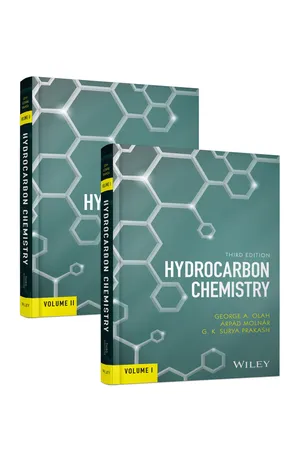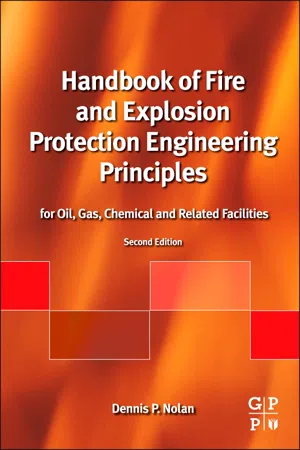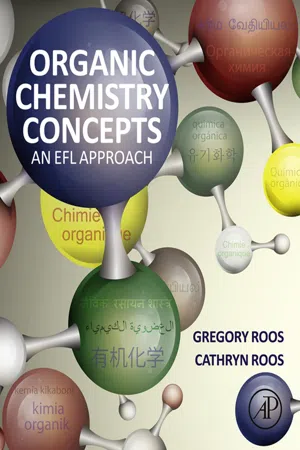Chemistry
Unsaturated Hydrocarbons
Unsaturated hydrocarbons are organic compounds that contain carbon-carbon double or triple bonds. They are more reactive than saturated hydrocarbons due to the presence of these double or triple bonds. Unsaturated hydrocarbons include alkenes, alkynes, and aromatic compounds, and are important in various industrial processes and in the production of plastics, fuels, and other chemicals.
Written by Perlego with AI-assistance
Related key terms
8 Key excerpts on "Unsaturated Hydrocarbons"
- eBook - ePub
- George A. Olah, Arpad Molnar, G. K. Surya Prakash(Authors)
- 2017(Publication Date)
- Wiley(Publisher)
1 Introduction and General AspectsHydrocarbon chemistry is essentially abiological organic chemistry although methane and fossil fuels and derivatives have biological origin.1.1 Hydrocarbons and Their Classes
Hydrocarbons, as their name indicates, are molecular compounds of carbon and hydrogen. As such, they represent one of the most significant classes of organic compounds (i.e., of carbon compounds).1 In methane (CH4 ), the simplest saturated alkane, a single carbon atom is bonded to four hydrogen atoms. In the higher homologs of methane (of the general formula Cn H2n+2), all atoms are bound to each other by single [(sigma (σ), two-electron, two-center] bonds with carbon displaying its tendency to form C–C bonds. Whereas in CH4 the H/C ratio is 4, in C2 H6 (ethane) it is decreased to 3, in C3 H8 (propane) to 2.67, and so on. Alkanes can be straight chain (each carbon attached to not more than two other carbon atoms) or branched (in which at least one of the carbon is attached to either three or four other carbon atoms). Carbon atoms can be aligned in open chains (acyclic hydrocarbons) or can form rings (cyclic hydrocarbons).Cycloalkanes are cyclic saturated hydrocarbons containing a single ring. Bridged cycloalkanes contain one (or more) pair(s) of carbon atoms common to two (or more) rings. In bicycloalkanes, there are two carbon atoms common to both rings. In tricycloalkanes, there are four carbon atoms common to three rings such as in adamantane (tricyclo[3.3.1.13,7 ]decane) giving a caged hydrocarbon structure.Carbon can also form multiple bonds with other carbon atoms. This results in Unsaturated Hydrocarbons such as olefins (alkenes, Cn H2n), specifically, hydrocarbons containing a carbon–carbon double bond or acetylenes (alkynes, Cn Hn - eBook - ePub
Handbook of Fire and Explosion Protection Engineering Principles
for Oil, Gas, Chemical and Related Facilities
- Dennis P. Nolan(Author)
- 2010(Publication Date)
- William Andrew(Publisher)
16 , occur in certain fragrant natural oils that are distilled from plant materials. These hydrocarbons are called terpenes and include pinene (in turpentine), and limonene (in lemon and orange oils).The most important group of unsaturated cyclic hydrocarbons is the aromatics, which occur in coal tar. All the aromatics sometimes exhibit unsaturation, that is, the addition of other substances, their principle reactions bring about the replacement of hydrogen atoms by other kinds of atoms or groups of atoms. The aromatic hydrocarbons include benzene, toluene, anthracene, and naphthalene.4.3. Characteristics of HydrocarbonsHydrocarbon materials have several different characteristics that can be used to define their level of hazard. Since no one feature can adequately define the level of risk for a particular substance, they should be evaluated as a synergism. These characteristics have all been tested under strict laboratory conditions and procedures that may alter when applied to industrial environments. The main characteristics of combustible hydrocarbon materials, which are of high interest for fire and explosion concerns, are described below.4.3.1. Lower explosive limit and upper explosive limitThe lower explosive limit (LEL) and upper explosive limit (UEL) is the range of flammability for a mixture of vapor or gas in air at normal conditions. The terms flammable limits and explosive limits are interchangeable. Where the range between the limits is large, the hydrocarbons may be considered relatively more dangerous e.g., hydrogen has a range of 4 percent to 75 percent, while gasoline has a range of 1.4 percent to 7.6 percent, when compared against each other, as it has a higher probability of ignition in any particular situation. Flammable limits are not an inherent property of a commodity, but are dependent on the surface to volume ratio and the velocity or direction of the air flow under the test. - eBook - ePub
- Jeffrey Gaffney, Nancy Marley(Authors)
- 2017(Publication Date)
- Elsevier(Publisher)
Hydrocarbons are compounds that contain only hydrogen and carbon atoms. There are three basic types of hydrocarbon structures: straight chain hydrocarbons, branched hydrocarbons, and cyclic hydrocarbons. The straight chain hydrocarbons form one continuous chain of carbon atoms bonded together in a straight line where each carbon atom is bonded to no more than two other carbon atoms. Branched hydrocarbons have one or more of the carbon atoms in the chain bonded to three or four carbon atoms creating a branch in the straight carbon chain. Cyclic hydrocarbons are hydrocarbons in which the carbon chain joins to itself forming a ring.The simplest of the hydrocarbons are the alkanes. Alkanes are a class of hydrocarbons that contain only sp 3 hybridized carbon atoms. They have the general formula Cn H2n + 2and tetrahedral geometries. The alkanes are sometimes referred to as saturated hydrocarbons , meaning that all carbon bonds in the molecule are sp 3 hybridized and all the bonds are σ single bonds. Each carbon is bonded to the maximum number of four neighboring carbon or hydrogen atoms. They are nonpolar and very chemically stable since they contain only C C and C H bonds. The larger alkanes are sometimes referred to as paraffin hydrocarbons because they appear waxy in the solid phase. Petroleum and natural gas are primarily composed of mixtures of alkanes.The simple alkanes are known as normal alkanes or straight chain alkanes. They are named according to the number of carbon atoms in the molecule. The names of the first 10 alkanes are listed in Table 13.1 . We have already looked at the simplest alkane, which is methane (CH4 ), containing only one carbon atom and four hydrogen atoms. The second alkane is ethane (C2 H6 ) containing two carbon atoms and six hydrogen atoms. The structure of ethane can be viewed as two CH3 groups bonded together or it can be viewed as a substituted methane with one hydrogen replaced by a CH3 group. The third compound, called propane, contains three carbon atoms and eight hydrogen atoms (C3 H8 ). Propane can also be considered to be a substituted methane, where two of the hydrogen atoms on methane are replaced by two CH3 groups. All three of these alkanes have one structural isomer possible. Structural isomers - eBook - ePub
- James G. Speight(Author)
- 2010(Publication Date)
- Gulf Professional Publishing(Publisher)
Chapter 9. Chemical and Physical Properties of HydrocarbonsContents1. Introduction3252. Stereochemistry3263. Molecular weight3294. Chemical properties3305. Physical properties3355.1. Boiling points and melting points3355.2. Density and specific gravity3435.3. Vapor density3475.4. Flash point and ignition temperature3485.5. Dew point350References3521. IntroductionHydrocarbons, the principal compounds of oil and natural gas, have to be chemically altered to make useful products and materials. This is carried out by changes in the chemical and physical structure. Such differences in molecular structure, even though the empirical formula can remain the same, cause significant differences in the properties and behavior of hydrocarbons and hydrocarbon fuels.Hydrocarbons are the simplest organic compounds and contain only carbon and hydrogen but they can be straight chain or branched chain (Stoker, 2008 ) with the same empirical formula but showing differences in properties.A hydrocarbon is any chemical compound that consists only of the elements carbon (C) and hydrogen (H) (Chapter 1 ). All hydrocarbons contain a carbon-chain skeleton and have hydrogen atoms attached to the carbon skeleton. Most hydrocarbons are readily combustible (Chapter 10 ). Almost all usable supplies of hydrocarbons are currently obtained from petroleum and natural gas.The hydrocarbons can be divided into various homologous series (Chapter 1 ). Each member of such a series shows a definite relationship in its structural formula to the members preceding and following it, and there is generally some regularity in changes in physical properties of successive members of a series.The alkanes are a homologous series of saturated aliphatic hydrocarbons. The first and simplest member of this series is methane, CH4 ; the series is sometimes called the methane series. Each successive member of a homologous series of hydrocarbons has one more carbon and two more hydrogen atoms in its molecule than the preceding member. The second alkane is ethane, C2 H6 , and the third is propane, C3 H8 . Alkanes have the general formula Cn H2n+2(where n is an integer greater than or equal to 1). Other homologous series of hydrocarbons include the alkenes and the alkynes (Chapter 1 - Albert S. Tarendash(Author)
- 2021(Publication Date)
- Barrons Educational Services(Publisher)
The properties detailed in this section support the view that the existence of ions or polar covalent bonds is commonly associated with inorganic compounds. In organic compounds, however, the bonding is usually covalent with little or no polarity. Carbon has four valence electrons, and in organic compounds it forms a total of four covalent bonds. We will see that carbon atoms may form single, double, or triple bonds by sharing one, two, or three pairs of electrons.Passage contains an image
11.3 Hydrocarbons and Homologous Series
The simplest organic compounds contain only carbon and hydrogen and are called hydrocarbons. Hydrocarbons are obtained from the refining of petroleum, a complex mixture of natural hydrocarbons. Petroleum is the starting point for the production of plastics, textiles, rubber, and detergents. The petroleum is separated into components with different boiling points by the process of fractional distillation. Another process, called cracking, is used to break the larger hydrocarbon molecules into smaller ones. This procedure increases the yield of the more important fractions with lower boiling points (such as gasoline). The simplest hydrocarbon is methane (CH4 ), which is the chief component of natural gas.Hydrocarbons with related structures and properties are usually separated into “families” known as homologous series. Each member of a series differs from the next member by a single carbon atom. With each successive member, the properties of the compounds, such as melting and boiling points, change in a regular way. This classification into series greatly simplifies the study of organic chemistry.The Alkane Series
Alkanes are hydrocarbons that contain only single bonds between carbon atoms. The first member of the alkane series is methane (CH4 ). In Chapter 9 , we discovered that methane is a tetrahedral molecule because carbon forms four sp3 hybrid orbitals—as it does in every- eBook - ePub
Water Quality Data
Analysis and Interpretation
- Arthur Hounslow(Author)
- 2018(Publication Date)
- CRC Press(Publisher)
Table 7.2 . Compounds with double or triple bonds have endings -ene or -yne, respectively. A two-carbon compound with one double bond is ethene (old name ethylene). A three-carbon compound with one triple bond is propyne.Isomers
Isomers are organic compounds with the same molecular formulas, but with different geometric structures. They are analogous to polymorphs in inorganic chemistry, e.g., calcite and aragonite have the same formula, namely CaCO3 , but different crystal structures.Structural isomers are compounds with the same molecular formula, but with a different carbon skeleton, that is, amount of branching. They contain four or more carbons. For example, butane may consist of a normal (η-butane) straight chain or a branched (iso-butane) isomer. Another type of branching is designated neo. The numbers of possible isomers for a variety of carbon atoms is shown in Table 7.3 . The compounds described above are straight- or branched-chain compounds called aliphatic compounds. These alkanes are commonly called paraffins.Table 7.2 Naming HydrocarbonsTable 7.3 Numbers of Hydrocarbon IsomersOlder Nomenclature
Straight-chain compounds are called normal and are written η-propane. Branched compounds are iso- if the branch is one carbon from the end, and neo- if one carbon atom has four other carbon atoms attached to it. The IUPAC names and the older names are given for some compounds in Table 7.4 .IUPAC Naming of Alkanes
The basis for naming aliphatic organic compounds is to determine the number of carbon atoms in the longest chain and to specify the position of branches.1. Find the longest unbranched chain, count the number of carbon atoms in this chain, designate by the appropriate stem, and add the suffix -ane. The names of the hydrocarbon stem for a variety of hydrocarbons are given in Table 7.2 - eBook - ePub
Organic Chemistry Concepts
An EFL Approach
- Gregory Roos, Cathryn Roos(Authors)
- 2014(Publication Date)
- Academic Press(Publisher)
Chapter 2Functional Classes I, Structure and Naming
Abstract
This chapter takes an initial look at the structure and representation of functional groups. The principles of the unambiguous systematic classification and naming of organic compounds are introduced. The importance of these for accurate information transfer is highlighted. Common functional classes are detailed and, where needed, three-dimensional diagrams, oxidation states, and physical properties are introduced.Keywords
3-D drawings; Carbon oxidation states; Conjugation; Molecular diagrams; Physical properties; Systematic compound naming2.1. Drawing and Naming Molecules
To understand the chemistry of organic molecules, we need to know the types of compounds that are possible. In this chapter we look at some details of the important functional classes introduced in Chapter 1 . Each compound class is shown with structural diagrams (how to draw the compounds) and systematic naming of the compounds. This background knowledge will prepare you for the chemistry in later chapters.2.2. Saturated Hydrocarbons
Hydrocarbon means that this class of compound has only carbon and hydrogen. In this broad grouping there are both: ▪ acyclic examples called alkanes; ▪ cyclic examples called cycloalkanes.All saturated examples have only single σ-bonds between sp 3 -hybridized carbon atoms and hydrogen atoms. This class gives the parent compounds from which all other functional types come from. They also serve as the parent compounds for systematic naming.Hydrocarbons have low chemical reactivity. This is because they have no reactive functional group. They simply consist of chains of tetrahedral carbon atoms which are surrounded by hydrogen atoms. Table 2.1 - eBook - ePub
- John T. Moore(Author)
- 2012(Publication Date)
- For Dummies(Publisher)
In the early years of chemistry, scientists believed that living organisms could only produce organic compounds with a vital force involved. In 1828, the German scientist Friedrich Wohler changed the field of chemistry forever by making an organic compound, urea, by accident while trying to make an inorganic compound. This work was the beginning of today’s modern field of organic synthesis.Scientists have since discovered many compounds of carbon. So many exist because carbon contains four valence electrons and so can form four covalent bonds to other carbons or to other elements. (Organic chemistry students commonly make a mistake when drawing structures by not making sure that every carbon has four bonds attached to it.) The bonds that carbon forms are strong covalent bonds, and carbon has the ability to bond to itself in long chains and rings. It can form double and triple bonds to another carbon or to another element. These properties allow carbon to form the vast multitude of compounds needed to make an amoeba or a butterfly or a baby.Organic chemistry is one reason why chemistry gets the reputation of being smelly. You have lab experiments, especially synthesis labs, where you can build complex molecules from simpler ones. The downside is the odor.This chapter provides a basic introduction into the world of organic chemistry. I explain hydrocarbons, which are compounds of carbon and hydrogen, as well as some of the other different classes of organic compounds and their uses.Hustling Hydrocarbons — the Simplest Organic CompoundsHydrocarbons are the simplest organic compounds; they’re composed of carbon and hydrogen. Economically, the hydrocarbons are extremely important to society, primarily as fuels. Gasoline is a mixture of hydrocarbons. You and I use methane (natural gas) and propane and butane, all hydrocarbons, for their ability to burn and release a large amount of energy.Hydrocarbons may contain only single bonds (the alkanes) or double bonds (the alkenes) or triple bonds (the alkynes). And they may form rings containing single or double bonds (cycloalkanes, cycloalkenes, aromatics). The following sections examine these different types of bonded carbons in more depth.
Learn about this page
Index pages curate the most relevant extracts from our library of academic textbooks. They’ve been created using an in-house natural language model (NLM), each adding context and meaning to key research topics.







